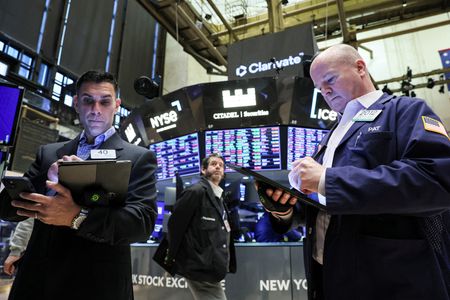
By Sinéad Carew and Amruta Khandekar
(Reuters) – Wall Street’s indexes ended down more than 1% on Friday after investors ran for the exits as they feared for the health of U.S. banks after the failure of a high-profile lender to the technology sector, overshadowing the February jobs report.
California banking regulators said they closed SVB Financial Group to protect deposits in what was the largest bank failure since the financial crisis. A capital crisis at SVB had already put pressure on bank stocks globally.
SVB had tried but failed to shore up its balance sheet through a stock sale proposed late on Wednesday. The same day, crypto-lender Silvergate Capital said it would have to wind down after huge losses from the FTX cryptocurrency exchange collapse.
“There’s concern cracks may be appearing in the financial system as a result of the Federal Reserve’s aggressive rate hikes,” said Carol Schleif, chief investment officer, BMO family office in Minneapolis. “The fear is whether it’s broader than one industry’s bank and one segment of the economy.”
While many investors looked through their bank holdings for signs of risk, Schleif said much of the weakness in regional bank stocks stemmed from a “proverbial shoot first ask questions later situation.”
The KBW regional banking index ended the session down 2.4% while the S&P 500 financials index lost 1.8%.
Schleif and other investors said they hoped regulations added to the U.S. banking system since the 2008 financial crisis would prevent a similar catastrophe.
But still “people are very nervous because they don’t want a repeat,” she said.
The Dow Jones Industrial Average fell 345.22 points, or 1.07%, to 31,909.64, the S&P 500 lost 56.73 points, or 1.45%, to 3,861.59 and the Nasdaq Composite dropped 199.47 points, or 1.76%, to 11,138.89.
All 11 S&P 500 industry sectors lost ground. Real estate, down 3.3%, led declines while consumer staples the top performer, fell just 0.5%.
For the week, the S&P lost 4.6% in its biggest weekly percentage decline since September but was clinging to a tiny year-to-date gain of 0.6%. The Dow fell 4.4% for the week and was down more than 3% year-to-date while the Nasdaq declined 4.7% this week but was up more than 6% for 2023.
The Cboe Volatility Index, an options-based indicator that reflects demand for protection against stock market declines, closed at a 3-month high, up 2.19 points at 24.9 after touching a roughly five-month high during the session.
MIXED JOBS REPORT
Investors had expected to end the week with most of their focus on economic data rather than banks.
Before the market opened, the closely monitored non-farm payrolls report showed the U.S. economy added more jobs than expected in February while average hourly earnings rose at a slower 0.2% last month after versus 0.3% in January while unemployment rose to 3.6%.
The data had eased some concerns that the Fed could raise rates by 50 basis points at its March meeting after hawkish remarks from Fed Chair Powell this week.
But investors were more focused on uncertainties around the bank system, said John Praveen, managing director & Co-CIO at Paleo Leon in Princeton, New Jersey.
“Whatever positive vibes came out of the labor market report were upstaged by negative vibes from the SVB situation,” Praveen said.
The S&P 500’s bank subsector closed down 0.5% with a boost from JPMorgan Chase, which closed up 2.5% and Wells Fargo , which closed up 0.6% while the rest of the index lost ground.
The biggest decliners were Silvergate cryto-bank peer Signature Bank, which tumbled 22.9% and regional bank First Republic, which finished down 14.8%.
In individual stocks, Gap Inc lost 6.3% after the apparel retailer posted a bigger-than-expected fourth-quarter loss and forecast full-year sales below Wall Street estimates.
Oracle Corp slid 3% after the software firm missed third-quarter revenue estimates.
Declining issues outnumbered advancing ones on the NYSE by a 4.75-to-1 ratio; on Nasdaq, a 4.31-to-1 ratio favored decliners.
The S&P 500 posted no new 52-week highs and 40 new lows; the Nasdaq Composite recorded 25 new highs and 493 new lows.
On U.S. exchanges 15.17 billion shares changed hands, well above the 11.13 billion average for the last 20 sessions.
(Reporting by Sinéad Carew and Saqib Iqbal Ahmed in New York, Amruta Khandekar and Shristi Achar in Bengaluru; Editing by Vinay Dwivedi and David Gregorio)

